Sensor Fusion Architecture for Fault Diagnosis with a Predefined-Time Observer
Abstract
1. Introduction
2. Sensor Fusion Architecture
2.1. Sensor Fusion Architecture
2.1.1. Homogenizer
2.1.2. Sensor Fusion
2.1.3. Filter
2.1.4. Voter
2.2. Diagnoser
- Then, the origin of (11) is predefined-time stable with as its predefined time.
3. Case Study
3.1. Prototype
3.2. Model of the Three-Wheeled Omnidirectional Mobile Robot
3.3. Signal Homogenizer
3.4. Sensor Fusion
3.5. Filter
3.6. Voter
3.7. Diagnoser
4. Results
Experimental Results
- Faults at the first actuator: during the interval and during the interval .
- Faults at the second actuator: during the interval and during the interval .
- Faults at the third actuator: during the interval , during the interval and during the interval .
5. Conclusions
Author Contributions
Funding
Data Availability Statement
Conflicts of Interest
References
- Flores-León, H.; Begovich, O.; Ruiz-León, J.; Ramírez-Treviño, A. Active fault detection and isolation in linear time-invariant systems: A geometric approach. Asian J. Control 2023, 25, 710–721. [Google Scholar] [CrossRef]
- Chen, J.; Patton, R.J. Robust Model-Based Fault Diagnosis for Dynamic Systems; Springer Science & Business Media: Berlin/Heidelberg, Germany, 2012; Volume 3. [Google Scholar]
- Delgado-Aguiñaga, J.; Besancon, G.; Begovich, O.; Carvajal, J. Multi-leak diagnosis in pipelines based on Extended Kalman Filter. Control Eng. Pract. 2016, 49, 139–148. [Google Scholar] [CrossRef]
- Lizarraga, A.; Begovich, O.; Ramírez, A. Real-Time Sliding Mode Fault Diagnosis for a Three-Wheeled Omnidirectional Mobile Robot. In Proceedings of the 2022 IEEE 18th International Conference on Automation Science and Engineering (CASE), Mexico City, Mexico, 20–24 August 2022; IEEE: New York, NY, USA, 2022; pp. 1953–1958. [Google Scholar]
- Gao, Z.; Cecati, C.; Ding, S.X. A survey of fault diagnosis and fault-tolerant techniques-Part I: Fault diagnosis with model-based and signal-based approaches. IEEE Trans. Ind. Electron. 2015, 62, 3757–3767. [Google Scholar] [CrossRef]
- Zhou, D.; Zhao, Y.; Wang, Z.; He, X.; Gao, M. Review on diagnosis techniques for intermittent faults in dynamic systems. IEEE Trans. Ind. Electron. 2019, 67, 2337–2347. [Google Scholar] [CrossRef]
- Delgado-Aguiñaga, J.A.; Begovich, O. Water leak diagnosis in pressurized pipelines: A real case study. In Modeling and Monitoring of Pipelines and Networks; Springer: Berlin/Heidelberg, Germany, 2017; pp. 235–262. [Google Scholar]
- Koch, W. Tracking and Sensor Data Fusion; Springer: Berlin/Heidelberg, Germany, 2016. [Google Scholar]
- Garcia-Huerta, R.A.; González-Jiménez, L.E.; Villalon-Turrubiates, I.E. Sensor Fusion Algorithm Using a Model-Based Kalman Filter for the Position and Attitude Estimation of Precision Aerial Delivery Systems. Sensors 2020, 20, 5227. [Google Scholar] [CrossRef] [PubMed]
- Bader, K.; Lussier, B.; Schön, W. A fault tolerant architecture for data fusion: A real application of Kalman filters for mobile robot localization. Robot. Auton. Syst. 2017, 88, 11–23. [Google Scholar] [CrossRef]
- Hachemi, L.; Guiatni, M.; Nemra, A. Fault diagnosis and reconfiguration for mobile robot localization based on multi-sensors data fusion. Unmanned Syst. 2022, 10, 69–91. [Google Scholar] [CrossRef]
- Ifqir, S.; Combastel, C.; Zolghadri, A.; Alcalay, G.; Goupil, P.; Merlet, S. Fault tolerant multi-sensor data fusion for autonomous navigation in future civil aviation operations. Control Eng. Pract. 2022, 123, 105132. [Google Scholar] [CrossRef]
- Abid, A.; Khan, M.T. Multi-sensor, multi-level data fusion and behavioral analysis based fault detection and isolation in mobile robots. In Proceedings of the 2017 8th IEEE Annual Information Technology, Electronics and Mobile Communication Conference (IEMCON), Vancouver, BC, USA, 3–5 October 2017; IEEE: New York, NY, USA, 2017; pp. 40–45. [Google Scholar]
- Zhang, Z.; He, X. Geometric Approach Based Fault Detection and Isolation: A Review. In Proceedings of the 2022 41st Chinese Control Conference (CCC), Hefei, China, 25–27 July 2022; IEEE: New York, NY, USA, 2022; pp. 4136–4141. [Google Scholar]
- Fridman, L.; Shtessel, Y.; Edwards, C.; Yan, X.G. Higher-order sliding-mode observer for state estimation and input reconstruction in nonlinear systems. Int. J. Robust Nonlinear Control IFAC-Affil. J. 2008, 18, 399–412. [Google Scholar] [CrossRef]
- Shtessel, Y.; Edwards, C.; Fridman, L.; Levant, A. Sliding Mode Control and Observation; Springer: Berlin/Heidelberg, Germany, 2014; Volume 10. [Google Scholar]
- Isidori, A. Nonlinear Control Systems; Springer: Berlin/Heidelberg, Germany, 1995. [Google Scholar]
- Ma, H.; Yan, L.; Xia, Y.; Fu, M. Kalman Filtering and Information Fusion; Springer: Berlin/Heidelberg, Germany, 2020. [Google Scholar]
- Gao, J.; Harris, C. Some remarks on Kalman filters for the multisensor fusion. Inf. Fusion 2002, 3, 191–201. [Google Scholar] [CrossRef]
- Hamadi, H.; Lussier, B.; Fantoni, I.; Francis, C. Data fusion fault tolerant strategy for a quadrotor UAV under sensors and software faults. ISA Trans. 2022, 29, 520–539. [Google Scholar] [CrossRef] [PubMed]
- Aldana-López, R.; Gómez-Gutiérrez, D.; Jiménez-Rodríguez, E.; Sánchez-Torres, J.D.; Defoort, M. Enhancing the settling time estimation of a class of fixed-time stable systems. Int. J. Robust Nonlinear Control 2019, 29, 4135–4148. [Google Scholar] [CrossRef]
- Trujillo, M.A.; Aldana-López, R.; Gómez-Gutiérrez, D.; Defoort, M.; Ruiz-León, J.; Becerra, H. Autonomous and non-autonomous fixed-time leader–follower consensus for second-order multi-agent systems. Nonlinear Dyn. 2020, 102, 2669–2686. [Google Scholar] [CrossRef]
- Tzafestas, S.G. Introduction to Mobile Robot Control; Elsevier: Amsterdam, The Netherlands, 2013. [Google Scholar]
- Nguyen, N.T. Model-reference adaptive control. In Model-Reference Adaptive Control; Springer: Berlin/Heidelberg, Germany, 2018; Chapter 6; pp. 126–127. [Google Scholar]
- Iqbal, M.; Bhatti, A.; Iqbal, S.; Khan, Q. Parameter estimation based fault diagnosis of uncertain nonlinear three tank system using HOSM differentiator observer. In Proceedings of the 2009 IEEE 13th International Multitopic Conference, Islamabad, Pakistan, 14–15 December 2009; IEEE: New York, NY, USA, 2009; pp. 1–6. [Google Scholar]
- Iqbal, M.; Bhatti, A.I.; Ayubi, S.I.; Khan, Q. Robust parameter estimation of nonlinear systems using sliding-mode differentiator observer. IEEE Trans. Ind. Electron. 2010, 58, 680–689. [Google Scholar] [CrossRef]


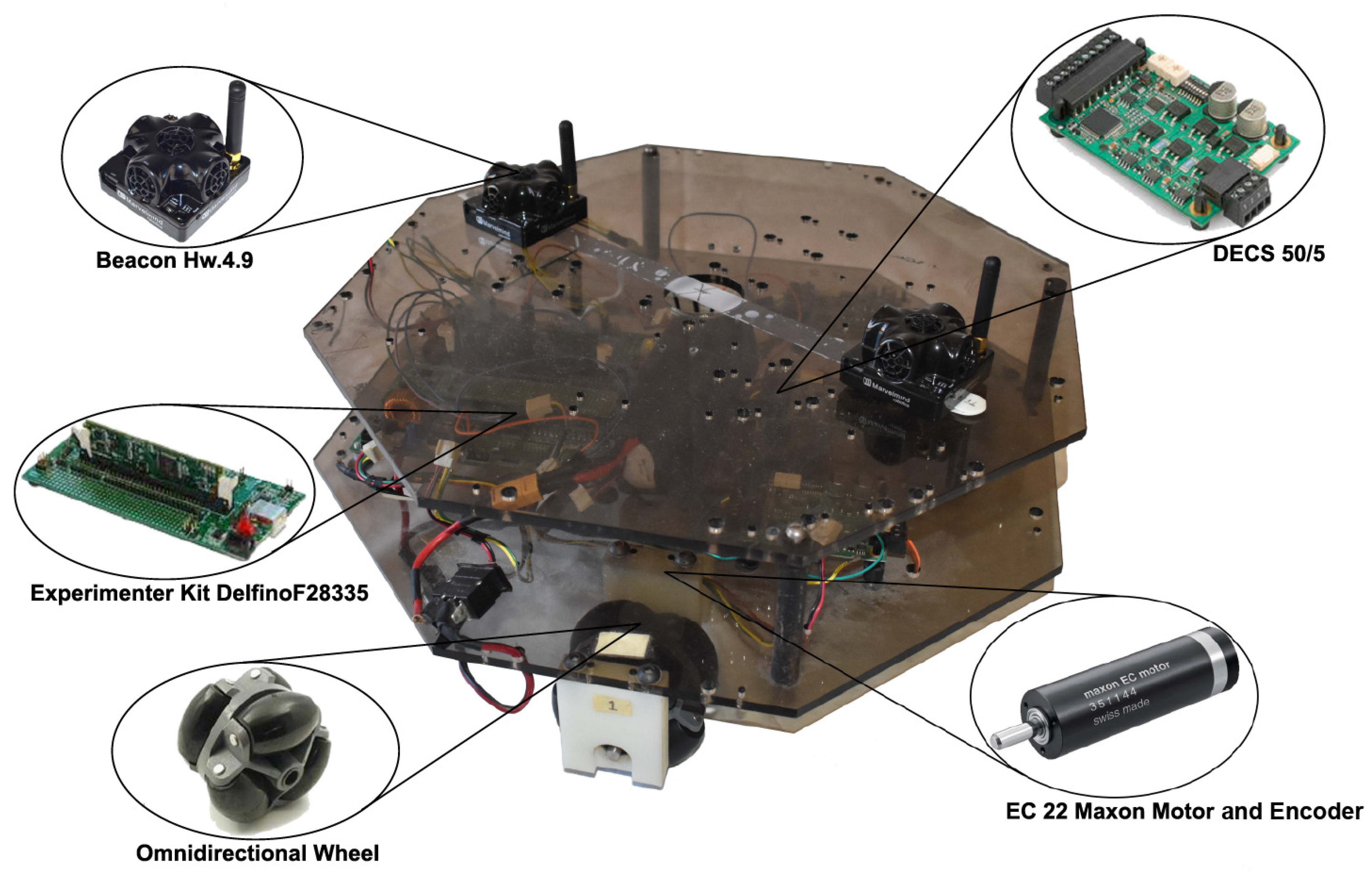
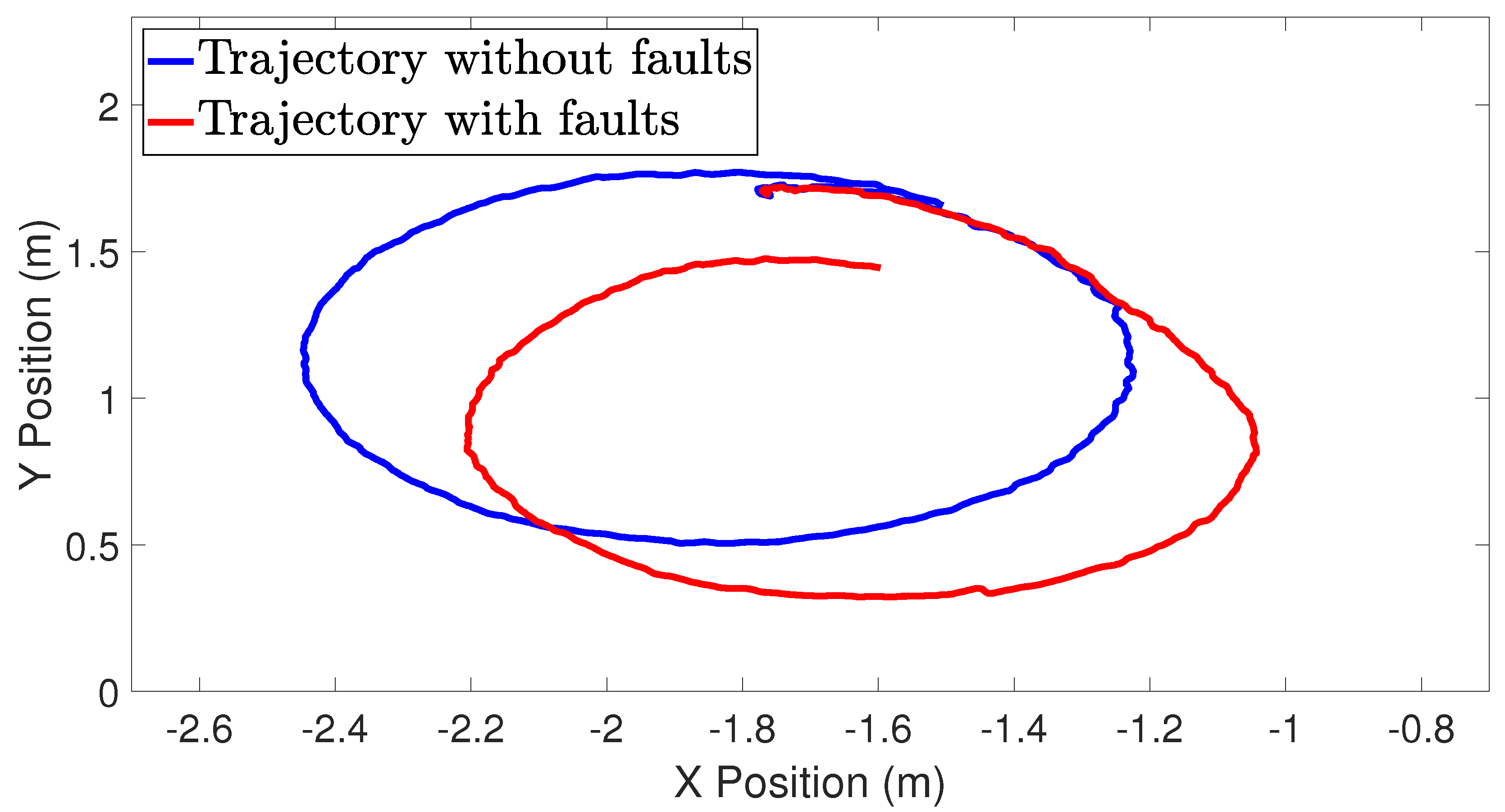
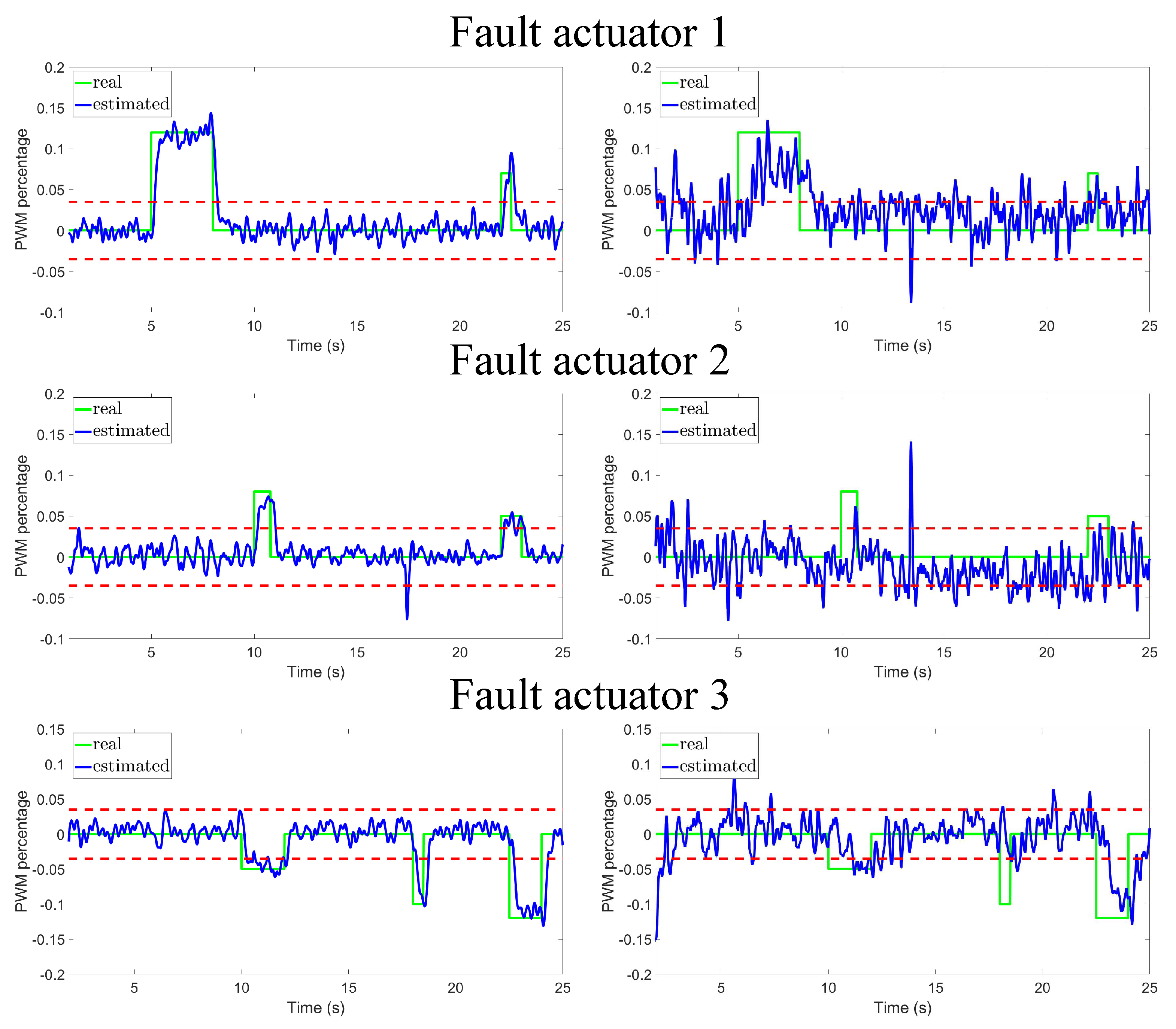
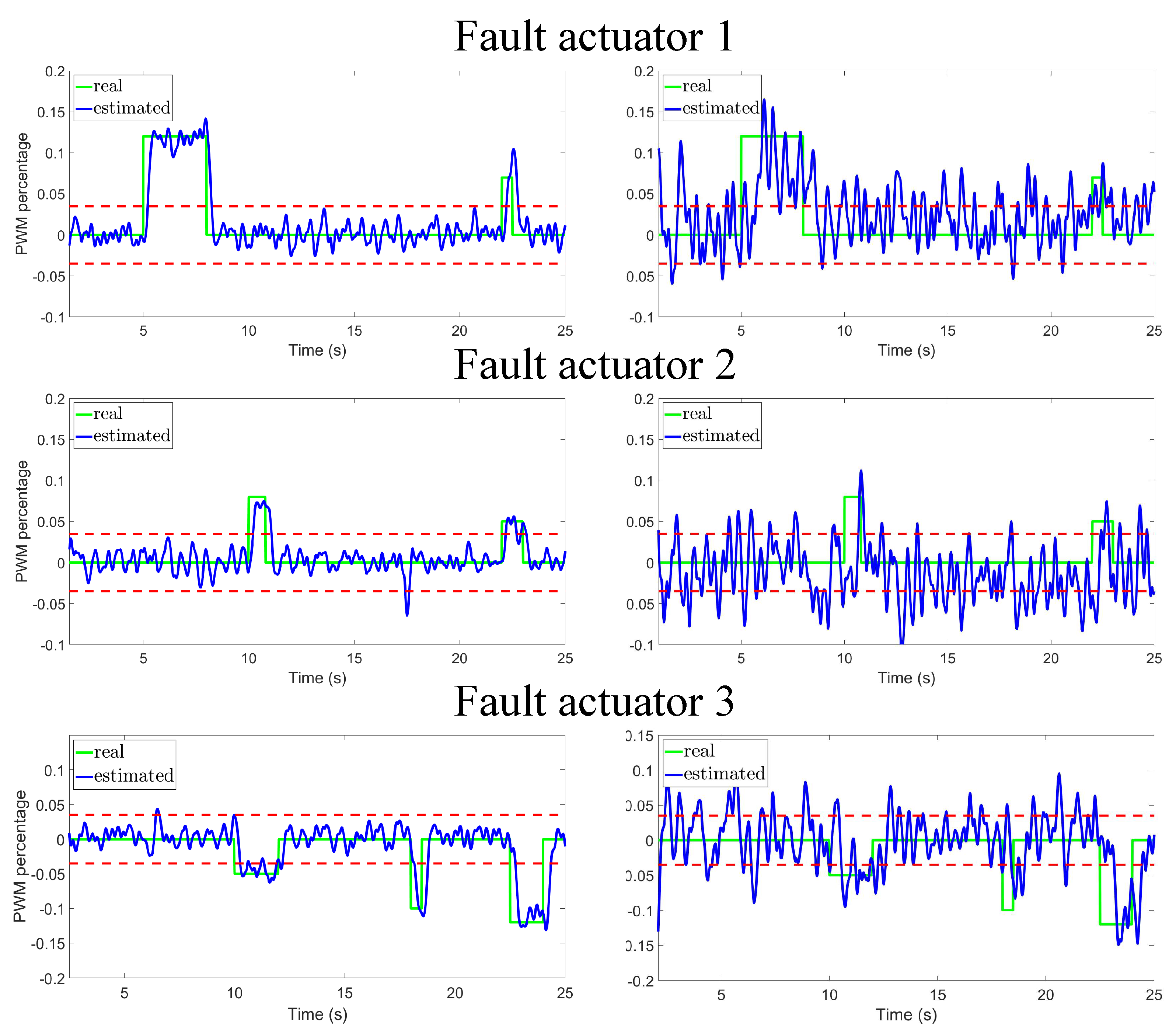
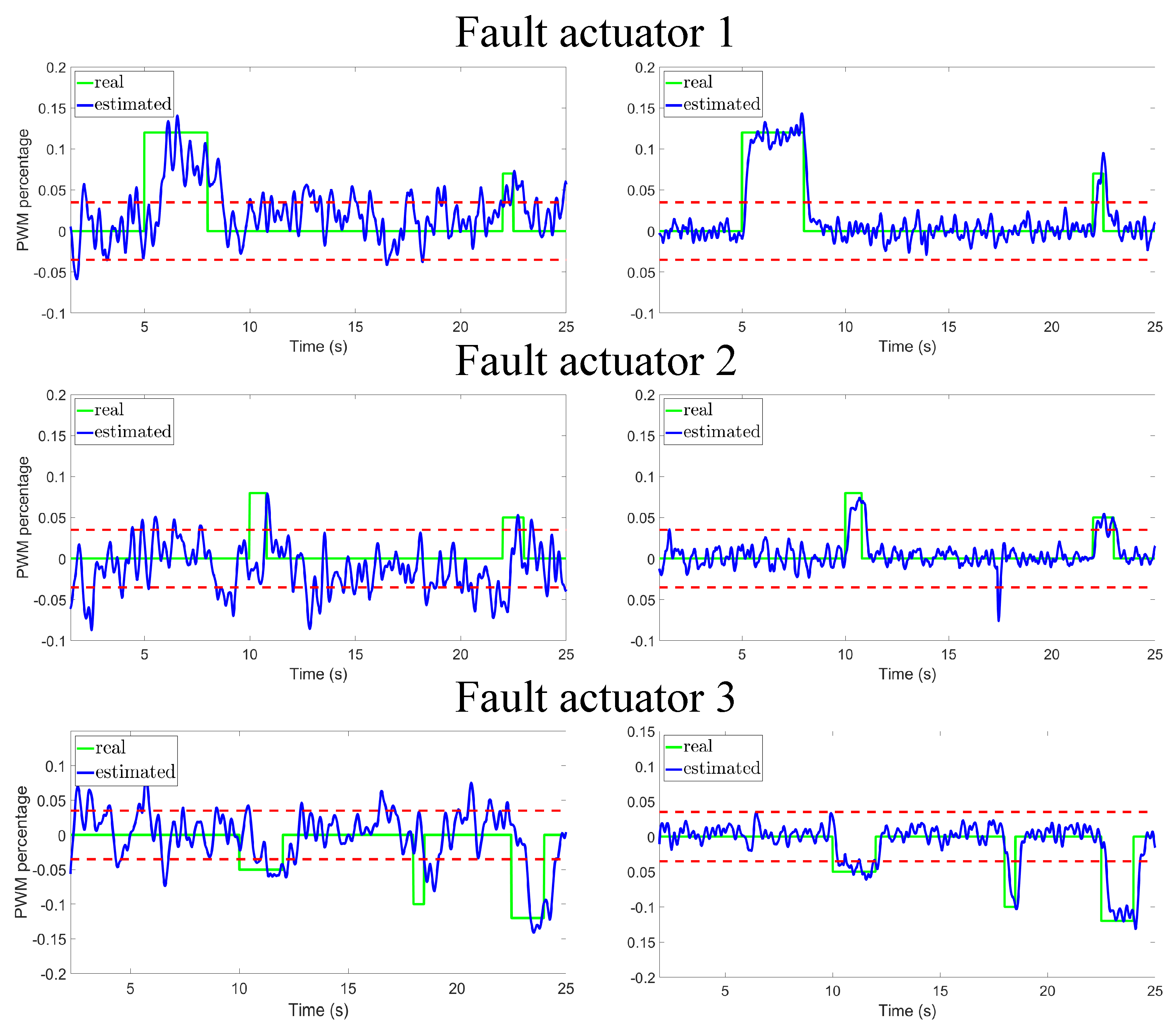
| Parameter | Value | Parameter | Value |
|---|---|---|---|
| −10.3949 | 2.9695 | ||
| 2.5026 | 29.5783 | ||
| −15.2935 |
| (GPS) | Variance | (Encoders) | Variance |
|---|---|---|---|
| (x) | 0.0772 | (x) | 0.0353 |
| (y) | 0.0173 | (y) | 0.0076 |
| () | 0.1245 | () | 0.0308 |
| () | 327,610 | () | 26,072 |
| () | 333,730 | () | 25,752 |
| () | 582,470 | () | 38,149 |
| () | 0.0022 | () | 0.0005 |
| () | 0.0018 | () | 0.0003 |
| () | 0.0083 | () | 0.0024 |
| Parameter | Value | Parameter | Value |
|---|---|---|---|
| 4.9968 | q | 3 | |
| 0.15 | k | 0.5 | |
| 1 | 100000 | ||
| 2 | 100000 | ||
| p | 1.5 | 300000 |
| Diagnoser | |||
|---|---|---|---|
| Predefined-Time | 0.0201 | 0.0147 | 0.0247 |
| HOSM | 0.0233 | 0.0166 | 0.0268 |
| Diagnoser | |||
|---|---|---|---|
| Predefined-Time | 0.0822 | 0.0808 | 0.0636 |
| HOSM | 0.0421 | 0.0428 | 0.0463 |
Disclaimer/Publisher’s Note: The statements, opinions and data contained in all publications are solely those of the individual author(s) and contributor(s) and not of MDPI and/or the editor(s). MDPI and/or the editor(s) disclaim responsibility for any injury to people or property resulting from any ideas, methods, instructions or products referred to in the content. |
© 2024 by the authors. Licensee MDPI, Basel, Switzerland. This article is an open access article distributed under the terms and conditions of the Creative Commons Attribution (CC BY) license (https://creativecommons.org/licenses/by/4.0/).
Share and Cite
Begovich, O.; Lizárraga, A.; Ramírez-Treviño, A. Sensor Fusion Architecture for Fault Diagnosis with a Predefined-Time Observer. Algorithms 2024, 17, 270. https://doi.org/10.3390/a17060270
Begovich O, Lizárraga A, Ramírez-Treviño A. Sensor Fusion Architecture for Fault Diagnosis with a Predefined-Time Observer. Algorithms. 2024; 17(6):270. https://doi.org/10.3390/a17060270
Chicago/Turabian StyleBegovich, Ofelia, Adrián Lizárraga, and Antonio Ramírez-Treviño. 2024. "Sensor Fusion Architecture for Fault Diagnosis with a Predefined-Time Observer" Algorithms 17, no. 6: 270. https://doi.org/10.3390/a17060270
APA StyleBegovich, O., Lizárraga, A., & Ramírez-Treviño, A. (2024). Sensor Fusion Architecture for Fault Diagnosis with a Predefined-Time Observer. Algorithms, 17(6), 270. https://doi.org/10.3390/a17060270






